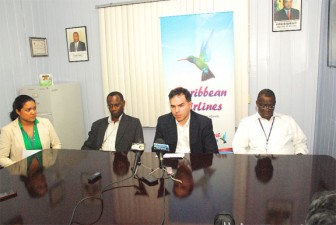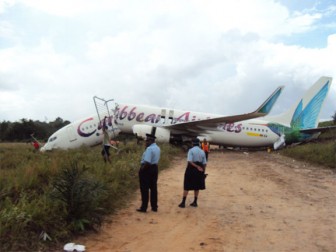By Alva Solomon and Mark McGowan
Investigators from the US National Transportation Safety Board (NTSB) are expected in Guyana tomorrow to remove the voice data recordings and the black box to determine the cause of yesterday’s crash at the Cheddi Jagan International Airport, Chairman of Caribbean Airlines George Nicholas said.
The probe into the incident is being spearheaded by NTSB and the Guyana Civil Aviation Authority (GCAA), Nicholas said, at a press briefing yesterday.
He was joined at the press briefing by a team of high-level officials who flew into the country yesterday morning following the incident. These included the Vice President of Maintenance and Engineering Colville Carrington, Vice President Operations Thomas Lawrence and Head of Corporate Communications Laura Asbjornsen.
Caribbean Airlines flight BW 524 skidded off the main runway at the Cheddi Jagan International Airport early yesterday morning and broke in two. There were 157 passengers and 6 crew members on board, Caribbean Airlines said. Though several were injured, there were no fatalities.

The officials were relatively tight-lipped at the news conference saying that they did not want to prejudice the investigation. They were unable say when the investigation will be completed, since the airline is not involved in the probe. They did not comment on whether they had raised concerns about the state of the airport previously with the authorities.
Questioned about the experience of the pilot, the officials said he has 25 years experience as a captain and has been flying to Guyana throughout this period. As far as his immediate future is concerned Nicholas said this would be dependent on the results of investigations. “We have an investigation with the Guyanese authorities to go through and once that is done we have our own internal process,” he said.
Nicholas said it was a miracle that the US$38 million aircraft, acquired in 2007, did not catch aflame or that persons were not killed or more seriously injured. “It’s an absolute miracle that took place today,” he said. “It’s amazing to have an aircraft in that shape with only a handful of injuries,” he said.

“We have been flying to Guyana for quite some time now and we want to be sure that we do right by the Guyanese people,” Nicholas said.
A post-trauma team was expected yesterday to meet crew and passengers. The airline will also be reaching out to customers to ensure that their recovery is as smooth as possible.
Meanwhile, local investigators are looking at the theory that pilot error might have been the key factor which resulted in the incident.
According to reports, the aircraft’s engine position and the general comments made by passengers about what they observed, are indications of what may have occurred during the last dreadful seconds of the flight.
According to an aviation source, the Boeing 737-800 series aircraft, bearing registration 9Y-PBM (Paramaribo) was one of the more modern aircraft types being operated by the airline. The source said that around 1.15 am yesterday, the flight was handed over to air traffic control at Timehri by Trinidadian authorities and the normal procedures were followed in guiding the aircraft into the airfield.
Some time around 1.20 am, the aircraft commenced its approach procedure for the main 7,500 ft runway 06 at the airport. Reports are that around 1.30 am, the aircraft touched the runway surface and within a matter of seconds, disaster followed.
The aircraft continued towards the end of the runway and slammed into the side perimeter fence of the airport before breaking in two.
According to a source, there are indications that the pilot may have landed the aircraft a considerable distance beyond the required touchdown zone on the runway in question for the aircraft type, with speed also playing a key factor. He said the runway surface was damp as there was rain prior to and during the incident and as such braking action would have been limited to some extent.
Based on passengers accounts of what transpired in the final moments of the flight, the pilots may have attempted to commence a missed approach, a procedure in which the navigator ought to raise the aircraft out of the descent mode into the air while in the vicinity of the runway when a successful landing is not possible.
However, a source who visited the scene told Stabroek News that he observed the aircraft engines were already in the “reverse thrust” mode, a position which indicated that massive braking would have been attempted by the pilots rather than an attempt to raise the aircraft back into the air. A Boeing pilot also supported this theory last evening.
There are also reports that the pilots would have steered the aircraft clear of a navigation structure, the localizer beacon, which is being constructed at the end of the runway close to where the aircraft ended up.
As the incident occurred, reports said, the air traffic controller on duty was able to carry out her assigned duties for such situations as the relevant organisations such as the Georgetown Public Hospital (GPH), the Guyana Defence Force Coastguard, Force Control and most importantly the Fire Department were notified of the incident within minutes of its occurrence.





